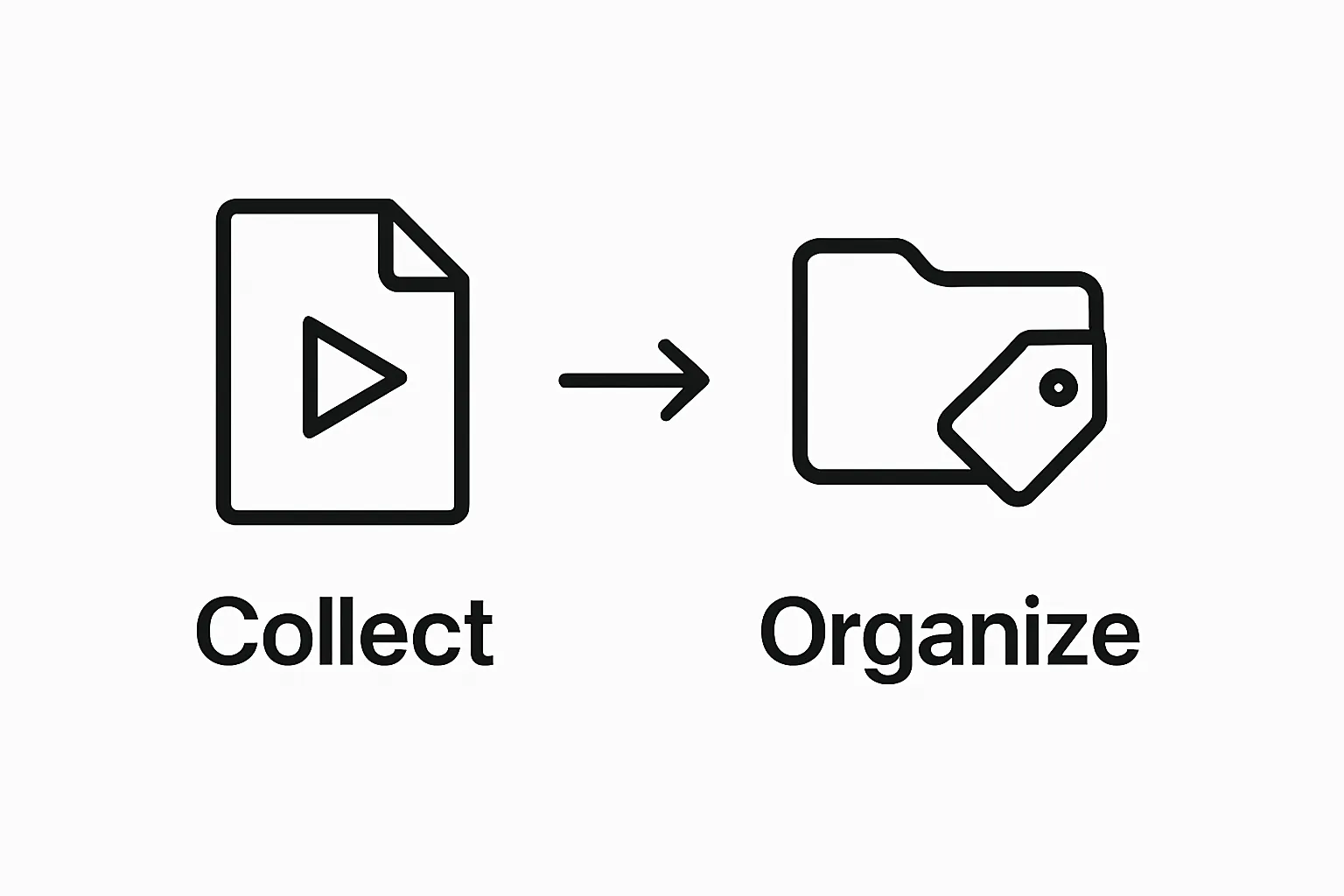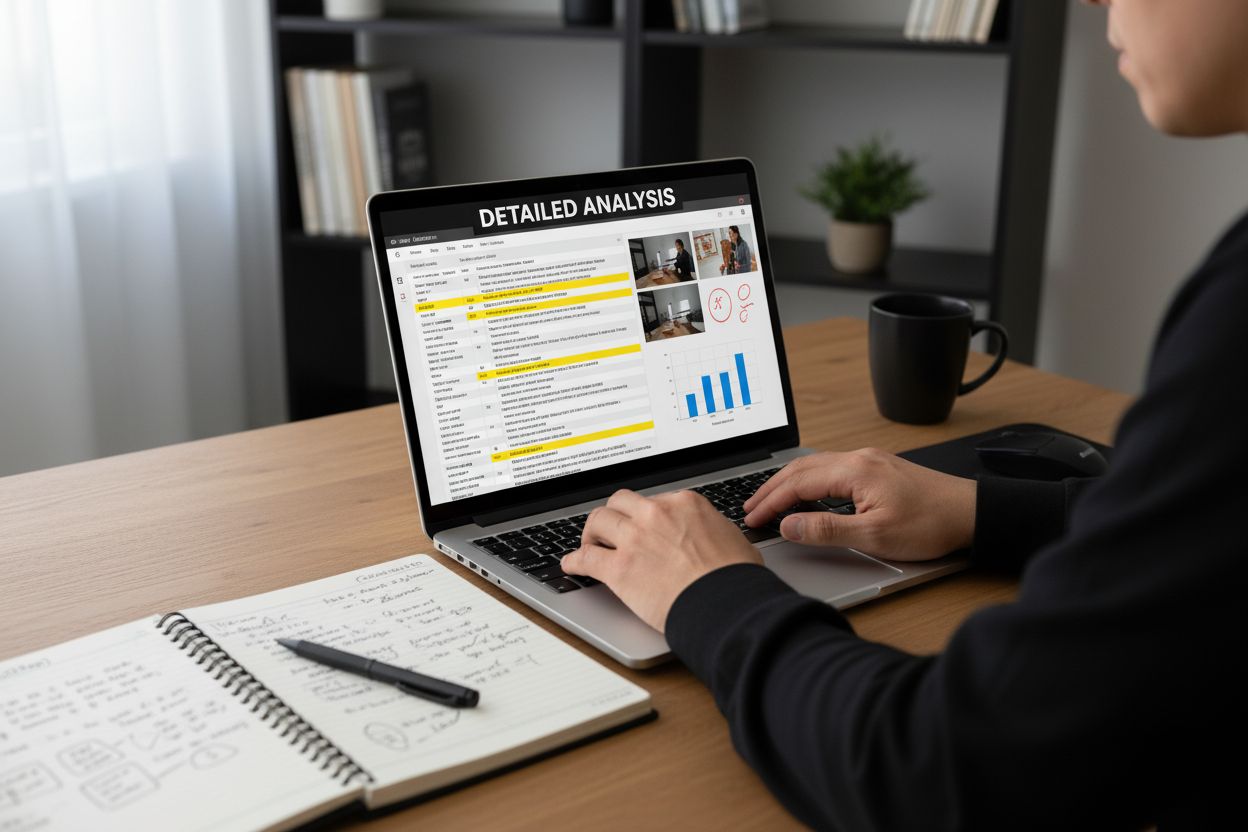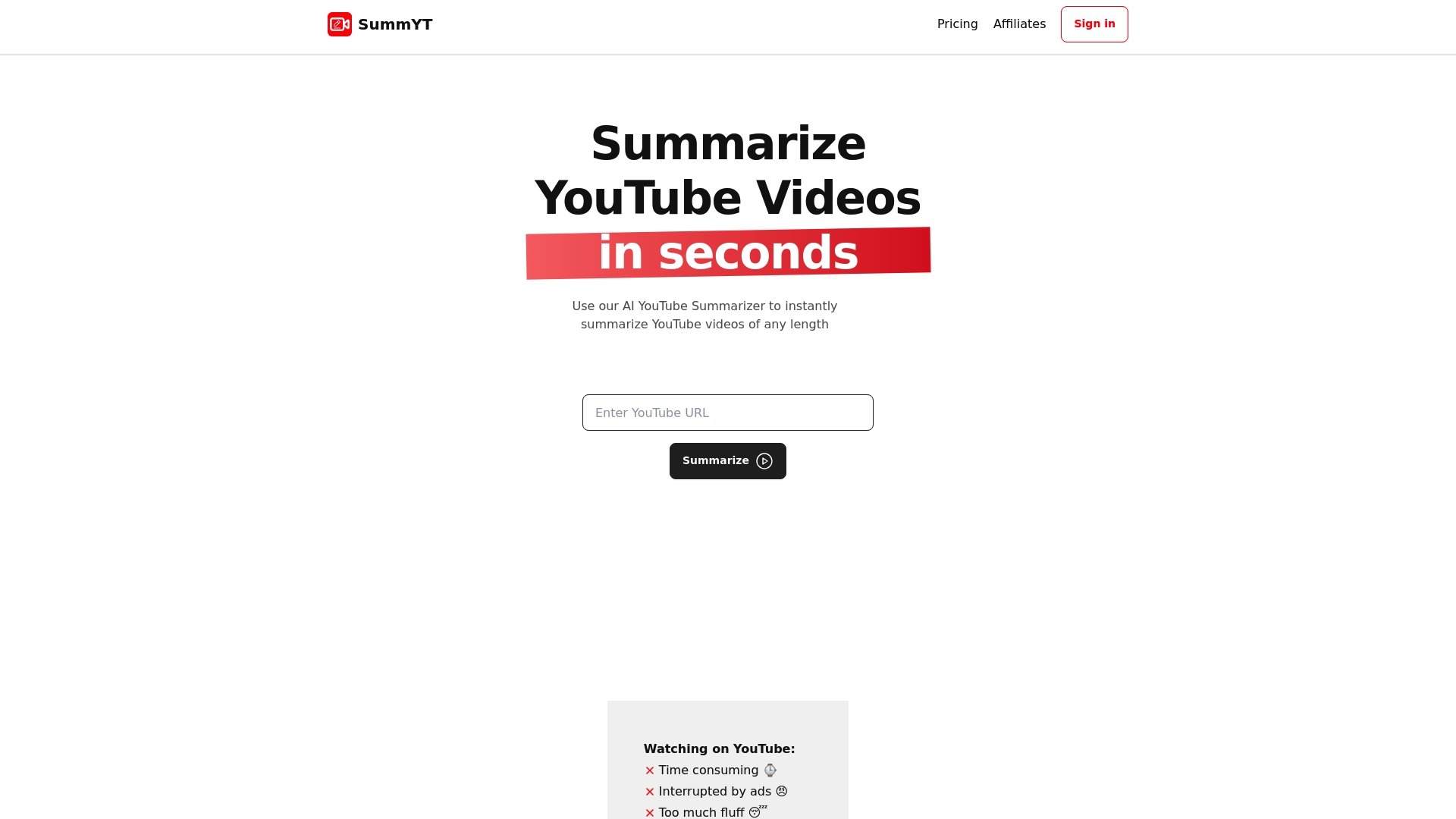Master Step by Step Video Analysis for Impactful Insights

Analyzing video content is more than just hitting play and taking notes. Studies show that over 80 percent of researchers struggle with organizing and extracting insights from raw video footage, despite all the tech available to help. Most people think video analysis only gets complicated once you start using advanced tools, but the real challenge actually begins with how you gather and structure your source videos in the very first step.
Table of Contents
- Step 1: Gather And Organize Video Content
- Step 2: Select Appropriate Video Analysis Tools
- Step 3: Execute Initial Video Review For Key Insights
- Step 4: Apply Detailed Analysis Techniques To Extract Data
- Step 5: Compile Analysis Findings In A Structured Format
- Step 6: Verify And Present Insights For Final Review
Quick Summary
| Key Point | Explanation |
|---|---|
| 1. Create a centralized storage system | Use cloud platforms or dedicated tools to manage video content effectively for organized research. |
| 2. Utilize high-quality video sources | Prioritize reputable content that aligns with your research goals for meaningful analysis. |
| 3. Segment videos for detailed analysis | Break videos into smaller sections for focused examination and clearer insights while maintaining context. |
| 4. Employ both automated and manual tools | Combine automated solutions for data extraction with manual tools for deeper qualitative insights. |
| 5. Develop a structured reporting framework | Create a comprehensive report with clear, visual representations of findings to enhance communication of insights. |
Step 1: Gather and Organize Video Content
Successful step by step video analysis begins with a strategic approach to collecting and organizing your source material. This initial phase sets the foundation for comprehensive and insightful video examination, transforming raw content into a structured resource for detailed investigation.
Start by creating a dedicated digital workspace where you can compile and manage your video content efficiently. Choose a centralized storage system that allows easy access and categorization. Cloud storage platforms or specialized video research tools work exceptionally well for this purpose. Consider creating folder structures that reflect your analysis goals, such as organizing videos by topic, date, or research category.
When gathering videos, prioritize high-quality and relevant sources. Look for content that directly relates to your research objectives. Academic lectures, professional conference recordings, expert interviews, and industry-specific presentations often provide the most robust material for in-depth analysis. Pay attention to the credibility of the source, the presenter’s expertise, and the recency of the information.
During the collection process, develop a systematic metadata tracking method. For each video, record critical information like title, speaker credentials, publication date, original platform, and a brief descriptive summary. This metadata becomes invaluable during later stages of your video analysis, helping you quickly reference and contextualize your research findings.
Technology can significantly streamline this gathering phase. Learn how to optimize your video summary workflow to make content collection more efficient. Utilize browser bookmarking tools, video download managers, and research organization software to simplify your workflow.
Before moving to the next analysis stage, perform a quick validation of your collected content. Verify that each video meets these key criteria:
- Directly relevant to your research objectives
- High audio and video quality
- Credible and authoritative source
- Covers the specific topics or insights you need
By meticulously gathering and organizing your video content, you create a solid groundwork that will support thorough and meaningful analysis in the subsequent steps of your research process.

Step 2: Select Appropriate Video Analysis Tools
Choosing the right video analysis tools is a critical step that can dramatically enhance the depth and quality of your insights. This phase transforms raw video content into a structured, analyzable resource by leveraging technology that matches your specific research objectives.
Begin by clearly defining the type of analysis you want to perform. Are you looking to conduct behavioral research, quantitative content assessment, or qualitative narrative examination? Different tools excel in specific domains. Academic and professional research often requires specialized software with robust coding and annotation capabilities. For content creators and marketers, more user-friendly platforms that offer quick visualization and key insight extraction work best.
Technical compatibility becomes a crucial consideration during tool selection. Evaluate your existing technological infrastructure and ensure the video analysis tool integrates smoothly with your current systems. Look for platforms that support multiple video formats, offer cloud storage options, and provide intuitive user interfaces. According to research on video analysis techniques, the most effective tools balance sophisticated analytical capabilities with ease of use.
Consider both automated and manual analysis tools. Automated solutions like machine learning algorithms can process large video datasets quickly, extracting patterns and insights that might be challenging to detect manually. Manual tools, on the other hand, provide deeper qualitative insights through frame-by-frame examination and detailed annotation.
Learn how to condense long videos for more engaging content can help you understand how different tools can streamline your analysis process. Some key features to look for include:
- Timestamp and segment marking capabilities
- Automated transcription services
- Data export and reporting functions
- Collaboration and sharing options
- Cross-platform compatibility
Before finalizing your tool selection, take advantage of free trials and demonstration versions. This hands-on approach allows you to test the software’s functionality, user experience, and alignment with your specific video analysis requirements. Pay attention to the learning curve, customer support quality, and potential scalability of the tool.
Below is a comparison table summarizing the different types of video analysis tools mentioned, their primary uses, and advantages to help you select the best fit for your project.
| Tool Type | Primary Use | Advantages |
|---|---|---|
| Automated Solutions | Large-scale data extraction | Fast processing, pattern detection |
| Manual Annotation | Qualitative, detailed insights | Deeper context, nuanced observation |
| Specialized Software | Academic/professional research | Advanced coding, annotation capabilities |
| Visualization Platforms | Quick key insight extraction | User-friendly, efficient presentation |
| Collaborative Tools | Multi-user analysis and sharing | Streamlined teamwork, cross-platform access |
Successful tool selection means finding a solution that not only meets your current analysis needs but can also adapt to future research complexities. The right video analysis tool becomes an extension of your analytical capabilities, transforming complex visual information into clear, actionable insights.
Step 3: Execute Initial Video Review for Key Insights
The initial video review is a strategic phase where you transform passive viewing into active research, extracting foundational insights that will guide your deeper analysis. This crucial step moves beyond simple observation, requiring a systematic and purposeful approach to understanding the video’s core content and underlying messages.
Begin by watching the entire video without interruption, focusing on developing a comprehensive understanding of its narrative arc and primary themes. Resist the temptation to pause or take notes during the first viewing. Instead, immerse yourself in the content, allowing your intuitive research instincts to capture the overall context, tone, and key messages. This initial passive review helps establish a holistic perspective before diving into detailed examination.
During your second viewing, transition into a more analytical mode. Activate your selected video analysis tools and start mapping out critical segments and potential points of interest. Look for moments that represent significant insights, unexpected perspectives, or data that align with your research objectives. Professional researchers often recommend creating timestamped markers that highlight these pivotal moments for future reference and in-depth exploration.
Learn how to outline video reports for clear presentations can provide additional strategies for capturing and organizing your initial observations. Pay special attention to elements such as speaker body language, tone variations, visual aids, and contextual references that might offer deeper meaning beyond the spoken words.
Develop a structured annotation approach during your review. Create a digital workspace where you can record observations, potential research questions, and initial interpretations. This might involve using split-screen technology to simultaneously view the video and document your insights, or utilizing specialized video analysis software that supports real-time note-taking and annotation.
Your initial review should help you verify several key aspects:
- Alignment of video content with research objectives
- Presence of unique or unexpected insights
- Quality and reliability of source material
- Potential areas requiring deeper investigation
By meticulously executing this initial review, you transform raw video content into a structured resource ready for comprehensive analysis. The insights gathered during this stage will serve as the foundation for more detailed examination in subsequent research steps, ensuring a robust and well-informed approach to video-based investigation.
Step 4: Apply Detailed Analysis Techniques to Extract Data
Detailed video analysis transforms initial observations into substantive, actionable insights through systematic and rigorous examination. This critical step goes beyond surface-level understanding, diving deep into the video’s content to uncover nuanced information that can drive meaningful research and decision-making.
Begin by segmenting the video into discrete analytical units. Break down the content into manageable sections that can be examined independently while maintaining their contextual relationships. This approach allows for a more granular and precise analysis, enabling you to capture subtle details that might be overlooked in a more generalized review. Professional researchers often use time-based segmentation, dividing videos into specific intervals that correspond to key themes, speaker transitions, or significant content shifts.
Employ multiple analytical techniques to extract comprehensive data. Qualitative methods like discourse analysis can help you understand narrative structures, communication patterns, and underlying rhetorical strategies. Quantitative approaches, such as frequency coding and statistical tracking, provide objective measurements of content elements like topic mentions, emotional tones, or visual composition.
Explore techniques for summarizing finance videos quickly and effectively to understand how specialized analysis can uncover critical insights. Utilize your selected video analysis tools to support these techniques, taking advantage of features like automated transcription, sentiment analysis, and advanced tagging systems.
Triangulation becomes essential in validating your findings. Cross-reference insights from different analytical approaches to ensure robust and reliable conclusions. This might involve comparing automated analysis results with manual coding, or synthesizing quantitative data with qualitative interpretations. The goal is to develop a multi-dimensional understanding that captures both the explicit and implicit dimensions of the video content.

During your detailed analysis, maintain a systematic documentation process. Create a structured data repository where you can:
- Record precise timestamps for key insights
- Log thematic categories and their frequencies
- Note unexpected patterns or anomalies
- Capture verbatim quotes or visual references
- Track potential follow-up research questions
Successful detailed analysis requires patience, methodical approach, and a willingness to explore multiple interpretive angles. By applying these comprehensive techniques, you transform raw video content into a rich, nuanced dataset that can provide profound insights across various research and professional domains.
Step 5: Compile Analysis Findings in a Structured Format
Compiling video analysis findings requires a strategic approach that transforms complex research data into clear, actionable insights. This critical step bridges the gap between raw information and meaningful communication, ensuring that your extensive research can be easily understood and effectively utilized by stakeholders.
Develop a comprehensive yet concise reporting framework that captures the essence of your video analysis. Start by creating a master document that serves as a central repository for your findings. This document should have a logical structure that reflects the progression of your research, from initial observations to detailed analytical insights. Professional researchers recommend using a hierarchical organization that allows readers to quickly navigate between high-level summaries and in-depth exploration.
Utilize visual representation techniques to enhance data comprehension. Incorporate charts, graphs, and infographics that translate complex video analysis data into easily digestible visual formats. These visual elements should not merely decorate your report but serve as powerful communication tools that highlight key patterns, trends, and significant insights discovered during your investigation.
Learn how to outline video reports for clear presentations can provide additional guidance on creating impactful research documentation. Focus on creating a narrative flow that guides readers through your findings, explaining not just what you discovered, but why those discoveries matter.
Metadata organization becomes crucial in this compilation phase. Create a systematic approach to documenting the context of your findings, including video source details, analysis methodology, and potential limitations. This transparency helps establish the credibility and reliability of your research, allowing others to understand the foundations of your insights.
Develop a standardized reporting template that ensures consistency and comprehensiveness. Your compiled findings should include:
- Executive summary of key insights
- Detailed analysis breakdown
- Visual representations of critical data
- Timestamps for significant video segments
- Potential implications and recommendations
- Methodological notes and research context
Pay special attention to the language and presentation of your findings. Use clear, precise language that communicates complex ideas without unnecessary jargon. The goal is to create a document that is both academically rigorous and accessible to your intended audience. A well-structured report transforms your video analysis from a collection of observations into a powerful tool for understanding, decision-making, and strategic insights.
Step 6: Verify and Present Insights for Final Review
The final verification and presentation stage transforms your meticulous video analysis into a compelling narrative that can withstand professional scrutiny. This critical phase is about validating your findings, ensuring methodological rigor, and communicating insights with clarity and confidence.
Triangulation becomes your primary validation strategy. Cross-reference your findings using multiple analytical approaches to eliminate potential bias and strengthen the reliability of your conclusions. This might involve comparing automated analysis results with manual coding, seeking corroborating evidence from additional sources, or consulting subject matter experts who can provide external perspective on your interpretations.
Prepare a comprehensive review presentation that tells a coherent story with your research. Structure your presentation to walk viewers through your analytical journey, demonstrating not just the what of your findings, but the how and why. Use clear visual representations that make complex data instantly comprehensible. According to research on presenting analytical results, annotated visual aids can significantly enhance stakeholder understanding and engagement.
Develop a critical assessment framework that allows for objective evaluation of your research methodology and conclusions. This framework should include transparent documentation of your research limitations, potential alternative interpretations, and areas requiring further investigation. Professional researchers understand that acknowledging research boundaries demonstrates intellectual honesty and scientific rigor.
When presenting your final insights, anticipate potential questions and challenges. Prepare supplementary materials that provide deeper context for your most significant findings. Create a presentation that not only reports data but also tells a compelling narrative about what the data means and why it matters.
Before finalizing your presentation, conduct a comprehensive verification process:
- Verify all data points and citations
- Check consistency across analytical segments
- Confirm alignment with original research objectives
- Review clarity and comprehensibility of visual representations
- Assess potential ethical considerations in your research
Consider organizing a peer review session where colleagues or subject experts can provide constructive feedback. This external perspective can help identify potential blind spots, refine your arguments, and enhance the overall quality of your video analysis insights. The goal is to create a presentation that is not just informative, but intellectually robust and persuasive.
This checklist table helps ensure your video analysis findings are fully verified and ready for presentation by listing the critical final review steps and what to check in each area.
| Review Step | What to Check |
|---|---|
| Data Verification | All data points and citations confirmed |
| Analysis Consistency | Consistent findings across analytical segments |
| Objective Alignment | Findings match original research objectives |
| Visual Clarity | Visual aids are clear and understandable |
| Ethical Assessment | Research meets ethical standards and guidelines |
| Peer or Expert Review | External feedback gathered and addressed |
Transform Your Step-by-Step Video Analysis with AI-Powered Summaries
Struggling with the time-consuming process of gathering, reviewing, and dissecting countless videos for deep insights? If you find yourself overwhelmed by the need to organize content, select the right tools, and extract valuable data, you are not alone. Many students, researchers, professionals, and lifelong learners face these exact challenges when conducting video analysis. What if there was a way to streamline every phase—making your workflow faster, more focused, and far less tedious?

Discover how SummYT accelerates your entire video analysis journey. In just minutes, SummYT delivers crisp, accurate summaries and key takeaways from any YouTube video. Automatically organize content, identify pivotal segments, and bypass irrelevant fluff. Experience unlimited summaries, boost productivity, and never miss the insights that matter most. Ready to save hours and make sense of any video fast? Start your smarter video analysis now with SummYT’s AI video summarizer or see how you can optimize your workflow step by step.
Frequently Asked Questions
What are the first steps in conducting video analysis?
Begin by gathering and organizing your video content in a dedicated digital workspace. Create a centralized storage system, choose high-quality sources relevant to your research, and develop a systematic metadata tracking method to document essential details about each video.
How do I choose the right video analysis tools?
Clearly define your analysis objectives first. Consider factors such as technical compatibility with your existing systems, user-friendly interfaces, and the specific functionalities you need, such as automated transcription or data export options. Take advantage of free trials to ensure the tool meets your requirements.
What techniques can I use for detailed video analysis?
Segment the video into manageable units based on key themes or content shifts. Implement qualitative techniques, such as discourse analysis, and quantitative methods like frequency coding. Validate your findings through triangulation, using multiple analytical approaches to ensure robust conclusions.
How can I effectively present my video analysis findings?
Compile your findings in a structured format that includes an executive summary, detailed analysis, and visual representations like charts and infographics. Ensure clarity and organization in your report, and prepare a compelling presentation that tells a coherent story about your research journey.




